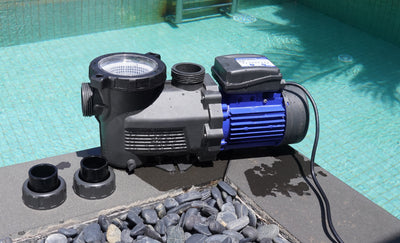How to Backwash a Sand Filter for a Super Clean Pool
Backwashing is a crucial maintenance step for keeping your sand filter efficient and your pool sparkling. This process reverses water flow through your filter, pushing out contaminants that build up over time. Regular backwashing ensures that your pool filter performs at its best, providing you with a clean and clear pool. Here’s everything you need to know about how and when to backwash a sand filter effectively.
What is Backwashing?
As water cycles through your pool's sand filter, particles like dirt, leaves, and other debris get trapped within the filter media (sand). Over time, this buildup can reduce your filter’s efficiency. Backwashing involves sending water in reverse through the filter, flushing out contaminants through a waste port, allowing your filter to work as if it were brand new. Regular backwashing helps you maintain excellent water quality without replacing the filter media frequently.
When Should You Backwash a Sand Filter?
There are a few key indicators that your sand filter needs backwashing:
-
Increased Filter Pressure: Check your pressure gauge regularly. When you notice the pressure reading at 10 PSI above the filter’s baseline pressure, it’s time to backwash. The baseline reading can be observed right after installing a new filter or after a fresh backwash.
-
Decreased Water Flow: A slow water flow from your return jets often indicates a clogged filter, which backwashing can resolve.
-
Cloudy Pool Water: If your water looks cloudy despite running the filter, it’s a sign that the filter is not capturing particles effectively due to clogging.
-
After Heavy Debris Load: Following a big storm or after removing large amounts of debris (like algae), backwashing will help your filter return to peak performance.
-
After Using Pool Flocculant: Using a flocculant can cause debris to settle at the bottom of your pool, and backwashing helps clean out the collected particles post-flocculant treatment.
How to Backwash Your Sand Filter: Step-by-Step Guide
The backwashing process is simple but effective, and following the correct steps will ensure you avoid damaging your filter system:
-
Turn Off the Filter System: Start by turning off your pool’s filter system.
-
Attach a Backwash Hose to the Filter Waste Port: Connect the backwash hose to your filter’s waste port, ensuring it’s directed toward a safe drainage area.
-
Set the Valve to Backwash: Adjust the multiport valve to the “Backwash” position, then turn your filter system back on.
-
Run the System Until Water Runs Clear: Let water flow through the backwash line until it runs clear, usually taking about one to two minutes. Watch the clarity in the sight glass or at the end of your hose.
-
Turn the System Off and Switch to Rinse: After backwashing, turn off the filter again and set the multiport valve to “Rinse.” This step helps reset the sand in the filter for optimal filtration.
-
Rinse for 30 Seconds: Turn the filter system back on and rinse for approximately 30 seconds.
-
Return the Valve to Filter Mode: Finally, turn the filter off and switch the valve back to “Filter” mode. Restart your system to resume normal filtering.
-
Refill and Balance Your Pool Water: Since backwashing removes some pool water, check the water level and top it off if needed. Afterward, test and balance your water chemistry as necessary.
Note: Always turn off your filter before adjusting the multiport valve. Changing the valve position while the filter is on may damage the valve and lead to leaks.
Troubleshooting: What if Backwashing Doesn’t Solve the Issue?
If your pool’s filter still shows signs of clogging or high pressure, you may need further inspection:
- Check Pool Chemistry: Sometimes, water quality issues like cloudy water aren’t due to the filter alone. Test and adjust chemical levels, including pH and calcium hardness, to ensure balanced water.
- Inspect the Filter for Damage: Over time, sand filters can experience wear and tear, potentially causing damage to internal parts like laterals (the small pipes that distribute water within the sand). Replace any damaged parts or consult a pool professional if necessary.
- Inspect for Clogs or Leaks: Blockages in the pool’s plumbing can restrict water flow. Check for any visible clogs or leaks in the system to ensure smooth circulation.
How Often Should You Replace Sand in a Sand Filter?
Typically, you’ll want to replace the sand in your filter every three to five years. Signs it’s time for a replacement include clumped or greasy sand, which will hinder effective filtration. When replacing the sand, use high-quality pool filter sand to achieve the best results.
Frequently Asked Questions About Sand Filter Backwashing
-
How Often Should You Backwash?
Backwash when your pressure gauge reads 10 PSI above normal, when you see cloudy water, or if the flow from your return jets is weak. A regular schedule can vary based on pool use, but frequent backwashing isn’t necessary for every cleaning. -
Do You Backwash or Rinse First?
Always backwash first to flush contaminants out, then use the rinse setting to settle the sand back into place for optimal filtration. -
How Long Should You Rinse After Backwashing?
Rinse for 30 seconds to one minute to ensure no sand returns to the pool. -
Does Backwashing Remove Pool Water?
Yes, backwashing causes water loss. Keep an eye on your water level and refill as needed.
Regular backwashing is key to keeping your sand filter running smoothly and your pool water clear. With a few simple steps, you can prevent clogs, improve filtration efficiency, and ensure a clean pool all season long. For premium pool equipment, explore AQUASTRONG’s products to keep your pool in perfect condition year-round.

